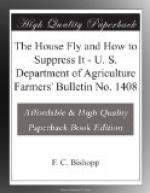The prevailing opinion that the house fly lives through the winter as an adult, hiding in cracks and crevices of buildings, etc., appears to be erroneous. Under outdoor conditions house flies are killed during the first really cold nights, that is, when the temperature falls to about 15 deg. or 10 deg. F. In rooms and similar places protected from winds and partially heated during the winter flies have been kept alive in cages for long periods, but they never lived through the entire winter. In longevity experiments one record of 70 days and another of 91 days was obtained. No uncaged house flies were found during three seasons’ observations in unheated and only partially heated attics, stables, unused rooms, etc., where favorable temperature conditions prevailed. The common occurrence in such places of the cluster fly and a few other species, which may be easily mistaken for the house fly, is responsible for the prevailing belief as to the way the house fly overwinters. There is therefore no reliable evidence whatever that adult house flies emerging during October and November pass the winter and are able to deposit their eggs the following spring, although they may continue active in heated buildings until nearly the end of January. On the other hand, there is evidence that house flies pass the winter as larvae and pupae, and that they sometimes breed continuously throughout the winter. In experiments at both Dallas, Tex., and Bethesda, Md., house flies have been found emerging during April from heavily infested manure heaps which had been set out and covered with cages during the preceding autumn. In the Southern States, during warm periods in midwinter, house flies may emerge and become somewhat troublesome; they frequently lay eggs on warm days.
The second way in which the house fly may pass the winter is by continuous breeding. House flies congregate in heated rooms with the approach of the winter season. If no food or breeding materials are present they eventually die. However, where they have access to both food and suitable substances for egg laying they will continue breeding just as they do outdoors during the summer. Even in very cold climates there are undoubtedly many places, especially in cities, where house flies would have opportunity to pass the winter in this manner.
CARRIAGE OF DISEASE BY THE HOUSE FLY.
The body of the house fly is covered thickly with hairs and bristles of varying lengths, and this is especially true of the legs. Thus, when it crawls over infected material it readily becomes loaded with germs, and subsequent visits to human foods result in their contamination. Even more dangerous than the transference of germs on the legs and body of the fly is the fact that bacteria are found in greater numbers and live longer in its alimentary canal. These germs are voided, not only in the excrement of the fly, but also in small droplets of regurgitated matter which have been called “vomit spots.” When we realize that flies frequent and feed upon the most filthy substances (it may be the excreta of typhoid or dysentery patients or the discharges of one suffering from tuberculosis), and that subsequently they may contaminate human foods with their feet or excreta or vomit spots, the necessity and importance of house-fly control is clear.




